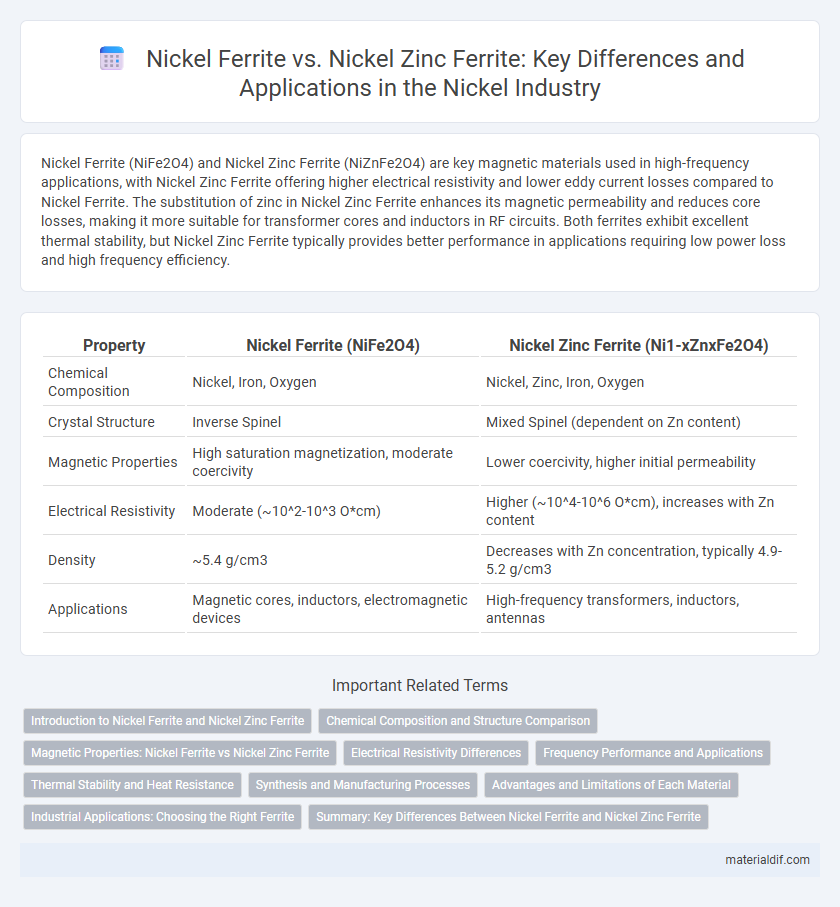Nickel Ferrite (NiFe2O4) and Nickel Zinc Ferrite (NiZnFe2O4) are key magnetic materials used in high-frequency applications, with Nickel Zinc Ferrite offering higher electrical resistivity and lower eddy current losses compared to Nickel Ferrite. The substitution of zinc in Nickel Zinc Ferrite enhances its magnetic permeability and reduces core losses, making it more suitable for transformer cores and inductors in RF circuits. Both ferrites exhibit excellent thermal stability, but Nickel Zinc Ferrite typically provides better performance in applications requiring low power loss and high frequency efficiency.
Table of Comparison
| Property | Nickel Ferrite (NiFe2O4) | Nickel Zinc Ferrite (Ni1-xZnxFe2O4) |
|---|---|---|
| Chemical Composition | Nickel, Iron, Oxygen | Nickel, Zinc, Iron, Oxygen |
| Crystal Structure | Inverse Spinel | Mixed Spinel (dependent on Zn content) |
| Magnetic Properties | High saturation magnetization, moderate coercivity | Lower coercivity, higher initial permeability |
| Electrical Resistivity | Moderate (~10^2-10^3 O*cm) | Higher (~10^4-10^6 O*cm), increases with Zn content |
| Density | ~5.4 g/cm3 | Decreases with Zn concentration, typically 4.9-5.2 g/cm3 |
| Applications | Magnetic cores, inductors, electromagnetic devices | High-frequency transformers, inductors, antennas |
Introduction to Nickel Ferrite and Nickel Zinc Ferrite
Nickel ferrite (NiFe2O4) is a magnetic spinel oxide known for its high electrical resistivity and excellent chemical stability, commonly used in electromagnetic and microwave applications. Nickel zinc ferrite (Ni1-xZnxFe2O4) is a modified spinel ferrite where zinc substitution enhances magnetic permeability and reduces magnetic losses, optimizing performance in high-frequency devices. Both materials are pivotal in advanced electronics, with nickel zinc ferrite offering tunable magnetic properties through zinc content adjustment.
Chemical Composition and Structure Comparison
Nickel ferrite (NiFe2O4) is a spinel ferrite composed of nickel ions (Ni2+) occupying the octahedral sites and iron ions (Fe3+) distributed between tetrahedral and octahedral sites, forming a cubic inverse spinel structure. Nickel zinc ferrite (Ni1-xZnxFe2O4) incorporates zinc ions (Zn2+) selectively substituting nickel ions in the structure, leading to a modification in cation distribution that enhances magnetic and electrical properties. The chemical substitution of Zn2+ ions in nickel zinc ferrite reduces magnetocrystalline anisotropy and lattice strain, altering the crystal field environment compared to pure nickel ferrite, which impacts the overall magnetic permeability and resistivity.
Magnetic Properties: Nickel Ferrite vs Nickel Zinc Ferrite
Nickel ferrite (NiFe2O4) exhibits high magnetic permeability and moderate saturation magnetization, making it suitable for inductors and transformers with stable magnetic properties. Nickel zinc ferrite (Ni1-xZnxFe2O4), by incorporating zinc, demonstrates enhanced magnetic permeability and reduced coercivity, improving its performance in high-frequency applications and soft magnetic devices. The substitution of zinc in nickel ferrite significantly decreases magnetic losses, optimizing nickel zinc ferrite for electromagnetic interference suppression and microwave technology.
Electrical Resistivity Differences
Nickel ferrite (NiFe2O4) exhibits moderate electrical resistivity typically ranging from 10^3 to 10^5 ohm-cm, influenced by factors such as grain size and sintering temperature. Nickel zinc ferrite (Ni1-xZnxFe2O4) shows significantly higher resistivity values, often exceeding 10^6 ohm-cm due to zinc substitution, which disrupts electron hopping mechanisms between Fe2+ and Fe3+ ions. This increased resistivity makes nickel zinc ferrite more suitable for high-frequency electromagnetic applications by reducing eddy current losses.
Frequency Performance and Applications
Nickel ferrite exhibits stable magnetic permeability and low loss at frequencies up to a few megahertz, making it suitable for inductors and electromagnetic interference (EMI) suppressors. Nickel zinc ferrite, with higher electrical resistivity, excels at maintaining low core losses and high permeability at higher frequencies, often in the range of tens to hundreds of megahertz, ideal for high-frequency transformers and microwave devices. Applications requiring efficient high-frequency performance, such as antennas and RF circuits, benefit from nickel zinc ferrite's superior frequency characteristics compared to nickel ferrite.
Thermal Stability and Heat Resistance
Nickel ferrite (NiFe2O4) exhibits strong thermal stability with a Curie temperature around 858 K, making it suitable for high-temperature applications. Nickel zinc ferrite (NiZnFe2O4) offers improved heat resistance and higher electrical resistivity, which reduces eddy current losses and enhances performance in high-frequency conditions. The substitution of zinc ions in nickel ferrite increases the material's thermal stability and magnetic properties, optimizing it for advanced electronic components exposed to elevated temperatures.
Synthesis and Manufacturing Processes
Nickel ferrite (NiFe2O4) is commonly synthesized using sol-gel and co-precipitation methods, producing uniform nanoparticles with enhanced magnetic properties. Nickel zinc ferrite (Ni1-xZnxFe2O4) requires precise doping of zinc ions during synthesis to modify its electrical and magnetic behavior, often achieved through hydrothermal or solid-state reaction techniques. Controlled heating and calcination are critical in both processes to optimize crystal structure and enhance magnetic permeability.
Advantages and Limitations of Each Material
Nickel ferrite (NiFe2O4) offers high magnetic permeability and chemical stability, making it ideal for high-frequency electromagnetic applications, but its comparatively higher electrical conductivity can lead to increased eddy current losses. Nickel zinc ferrite (NiZnFe2O4) provides lower electrical conductivity and enhanced resistivity, which reduces eddy current losses and improves performance in high-frequency devices, though it may exhibit lower saturation magnetization than nickel ferrite. Selection depends on balancing the need for magnetic efficiency versus electrical resistance in specific electronic and microwave components.
Industrial Applications: Choosing the Right Ferrite
Nickel ferrite exhibits high electrical resistivity and excellent magnetic permeability, making it suitable for inductors and electromagnetic interference suppression in electronic circuits. Nickel zinc ferrite offers enhanced frequency response and lower core losses, ideal for high-frequency transformers and power inductors in telecommunications and power electronics. Selecting the appropriate ferrite depends on the specific application frequencies, thermal stability requirements, and magnetic performance needed in industrial environments.
Summary: Key Differences Between Nickel Ferrite and Nickel Zinc Ferrite
Nickel Ferrite (NiFe2O4) exhibits a spinel structure with notable magnetic permeability and electrical resistivity, making it ideal for high-frequency transformers and inductors. Nickel Zinc Ferrite (NiZnFe2O4) incorporates zinc ions, enhancing resistivity and reducing magnetic losses, which improves performance in high-frequency applications and electromagnetic interference suppression. The key differences lie in their magnetic properties and electrical resistivity, where Nickel Zinc Ferrite offers superior resistivity and lower eddy current loss compared to Nickel Ferrite.
Nickel Ferrite vs Nickel Zinc Ferrite Infographic

 materialdif.com
materialdif.com